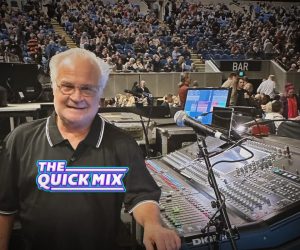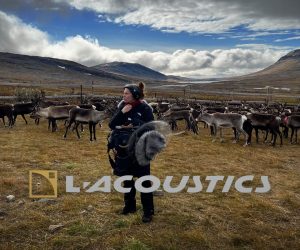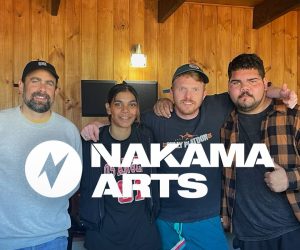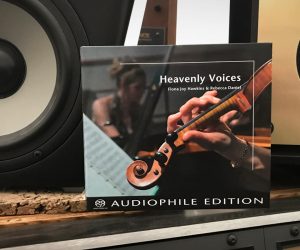
Stephen Witherow: Mixing For Screen
Greg Walker digs a bit deeper to find out how his compositions for TV get handled in the mix.
Mixing sound for film and TV is one of those ‘transparent’ jobs where, if it’s done well, nobody notices that it’s been done at all. Having worked recently as a composer for the ABC TV series Miss Fisher’s Murder Mysteries, I was impressed by how much impact mixer Stephen Witherow had on the final product with his careful massaging of background atmospheres, sound effects, music and of course the all important dialogue. Mixing for the screen requires much more than just technical expertise — it also demands a sound understanding of what makes good drama, an ability to oversee and advise on everything from sound effects, foley and music to ADR (Automatic Dialogue Replacement) and performances. Just as important as all this is the ability to effectively communicate with all the parties involved in the post-production process and to help realise the vision of the director and producer.
I interviewed Stephen at Labsonics in South Melbourne where he currently does most of his work, and asked him how he came to be caught up in the screen mixing caper.
Stephen Witherow: At school I was a science major but I was also involved in a lot of behind the scenes work in the school theatre doing lighting and sound. I also liked pulling apart home stereos and that kind of stuff. After school I went off and did pharmacy but pretty quickly realized I didn’t want to spend the rest of my life being a pharmacist. On the last day of semester I found out that there was a new intake for the ABC’s Production Operation Trainee Course and applications closed at 4pm that day. I managed to get my application in at about 3:30 and ended up being offered a place. So starting in 1983 I did three years of training with the ABC, almost like an in-house paid TAFE course. You got trained in all areas so you spent the first year doing a series of exams, learning electronics theory and light theory and then you’d play with studio cameras for a while and then go off and spend a week in the wardrobe department, set design or outside broadcast. I did things like working for a couple of weeks out at Healesville sanctuary helping film little marsupial rats that only come out at a certain time of the night.
At the start of the second year we had to choose which area we wanted to work in and I chose sound and spent half my time at the college and half my time in the studio. So I swung a boom and put radio mics on people and worked on the floor and hung audience mics and miked up bands and ran foldback systems on shows like Countdown. I also worked on Rock Arena and some comedy shows that had live bands so there was a fair bit of live stuff. When I finished my course I went into the sound department full-time and fairly quickly started mixing some comedy shows and then a year or so later I started doing drama. I worked on a show called House Rules which was interesting because we’d do our own sound recording on set for two weeks, then go off and do Countdown or the golf, cricket, whatever, for a few weeks, then come back and do the post-production and the sound mix. That was my first drama and I went on to do a lot of other shows at the ABC before finishing up in 1994. I received an offer to move over to Labsonics, which is an independent post-production facility, and I’ve been working here ever since.
Greg Walker: Sounds to me like you’ve had a real breadth of experience in making TV, which would be very handy in your mixing work.
SW: It is! One of the things I pride myself on is the ability to work quickly, which I learnt at the ABC. Although you kind of cut your own throat a bit because once people discover you can do things quickly they demand it all the time. I’d left the ABC but they asked me to come back in as a freelancer and run the music side of Recovery, which was basically their Countdown replacement. I was the engineer for the guest producers who came in, usually it was Tony Cohen or Chris Thompson, and I’d do the groundwork so they could swan in and push the faders around and we’d do music live to air on a Saturday morning.
GW: And were you working predominantly with analogue at that time?
SW: The ABC was still recording to 24-track analogue with Tascam DA88s for foley and stem mixes but at Labsonics we invested in an 8-track Fairlight system for dialogue editing and eventually moved to an Avid machine.
GW: You mentioned before about working quickly. Given that the technology has improved workflows so much from the old days of waiting for tape machines to rewind and old digital to find all the ones and zeros. How much pressure is there now to deliver a bigger better result and do it faster?
SW: I think the psychological aspect of working on a drama hasn’t changed that much. You still have to watch something, listen to it, make your assessment on it and change it. But what we’re delivering now is of a vastly superior quality to the product we were delivering 15 years ago. That’s the big difference. Generally I’d say we’re still given about the same amount of time to do the actual work, but we get a much better result.
GW: So what are the challenges of mixing for film and TV?
SW: This job is about having an impact on the way the show feels without actually appearing to have an impact. The problem with this job is it’s often seen as not being particularly creative, although I think that’s probably undervaluing it a little, so you have to be very careful about how you work around the other personalities involved. I sit here every day and I have to make ten thousand decisions about how a show is going to sound without consulting anybody about any of them. Predominantly it’s how I feel about each scene and what I’ve learnt from the briefings and the backgrounds and track records of the directors, producers, sound designers and composers. It’s also important how much sound knowledge the producers have; some of them are very possessive, some of them ask for a lot of feedback from me. Sometimes you’re invited to have an opinion on a particular scene and sometimes you’re not, so you have to be diplomatic in your approach. In the early meetings and briefings I try to do a lot more listening than talking and understand what it is people are trying to achieve. It’s also about whether they’ve actually got an aesthetic, do they actually know what they’re asking for or are they basically saying ‘here’s all our ideas, turn it into something’.
GW: So once you’ve made those ten thousand decisions there is a feedback and approvals process that is pretty important.
SW: There is, and it varies a lot depending on how many times the producer and director want to see screenings. Once you’ve established a working relationship with someone on a drama series they’ll often trust that you understand the overall product and leave all those decisions to you. ninety nine percent of the time the things they’ll want changes to are the adr and the way the music relates to the images and the other sound components. Because we work fast, the relationships between the atmospheres, sound effects and the music are pretty cut and dried and we need to go in and fine-tune those together.
GW: Do you get the chance to have much of a dialogue with the sound recordists?
SW: I do, but a lot of the time we’re so far behind them in the production timeline that they’re done and dusted before I’m even employed. Generally speaking most sound recordists are using really good equipment these days: good mics, digital recorders and digital mixers. What really shows one sound recordist up from another is the quality of their radio mic sounds. Some are infinitely useable and others are totally unusable. It’s mainly about how they’re put on the actor and whether the recordist is tuned in to check on them in case they’ve slipped down someone’s shirt or dress. It’s also a bit to do with whether wardrobe has accommodated them in the clothing design and whether they’ve been attached by the senior guy or a part time assistant — there’s a lot of variables there.
GW: Working on a period drama like Miss Fisher, the sound effects and foley really do add up in terms of selling the authenticity of the period. What are the challenges there?
You kind of cut your own throat a bit because once people discover you can do things quickly they demand it all the time

GW: You don’t have issues with latency?
SW: We do, but the biggest problems are with compatability between RTAS and TDM systems. Source Connect was actually developed as an RTAS application and it works best in that format so we have a dedicated LE system for ADR here.
GW: What’s your main house system here?
SW: We’re running a ProTools 10 TDM system on a Mac Pro with 5 HD Accel cards and that gets me through most projects. I can always grab a couple more cards from another room if I’m dealing with something bigger than usual. I mix on a Digidesign ProControl with an extra 8-channel side-car and the monitoring is all Quested.
GW: What kind of EQ and compression do you use on a daily basis in your work?
SW: I still use a lot of Focusrite plugs in ProTools, partly because I started with them and I find them to be really quick and easy to use. I’ve changed all the default settings so that the frequencies and the Qs are all sitting where I want them to start at, and I’ve got different ones for dialogue, effects, atmospheres and music. Just for quick knockabout work I find them really good and also DSP friendly. You can get 70 or 80 instances on a system like this without so much as a blip. I also use the basic ProTools EQs like the EQ3 when I want really steep 24dB curves for tidy-up work. I use them to roll off everything below 50Hz on things like atmospheres. Below 50Hz isn’t doing a whole lot of good on telly anyway, unless it’s something like the Beaconsfield Mining Disaster where we had a lot of stuff going on between 20-50Hz which we needed to control, but which was also a really important part of the show’s environment. Other than that I use Impact and a few other plug-ins for ordinary compression, all pretty standard stuff really.
GW: I guess everyone’s got a slightly different set of tools that they like to use but the fundamentals don’t really change do they?
SW: That’s right. I use Revibe for most of my reverbs and I use TL Spaces when I want to create environments. If I need something different I’ll go looking for it. I think the way I work goes right back to the old days using analogue consoles and a few outboard compressors and reverbs. You really didn’t have that great a range of tools, and unless you’re doing more sound design-oriented things you don’t need that much stuff now either. I do use phasers and backwards reverbs a bit for trippy scenes and flashbacks where you’re basically saying to the audience ‘this is not normal’, and I sometimes use those two effects on top of each other to get an effect. We do a bit of that on this show for the flashbacks but it’s a bit different with a period drama. Often with those kind of scenes you’d put in all your foley, reverb it up, and fiddle with the voices but I think this show is more about taking things out and being more minimalist with the mix so you’re seeing things but not hearing it.
GW: No-one ever really talked about it but it seems like we all reached the same conclusion that modern effects and sounds didn’t belong in this show.
SW: Miss Fisher exists within a very specific world that really doesn’t include those kind of sounds — we’re playing by the rules of the period.
SW: It’s very difficult on a show like this because you’re dealing with a lot of things that either don’t exist or are very rare. To source a good recording or find the original car or original gun or whatever and record it is very time consuming and we often don’t have the time. If it was a feature film you’d write a list and set aside time to record or source all that stuff but in a drama series you’ve just got to do your best on a much tighter timeline. And the same goes for the ADR. On a feature or telemovie you might do two rounds of ADR rather than just one. It’s really weird with actors, you can get them in once and you’ll get a very constricted performance and the second time it’s totally different. It’s pretty overwhelming for them. Often it’s the first time they’ve seen the pictures of themselves and suddenly they’re redoing their lines.
GW: So they really haven’t seen anything and then you show them what they’ve done wrong!
SW: That’s right. A lot of the actors in Aussie drama don’t have a lot of experience doing ADR, or they might have had bad experiences with it, so you’ve got to be careful how you handle them too.
GW: How often are you in a situation where you need to do ADR with an actor who is overseas?
SW: More and more. There’s a thing we use called Source Connect that lets us lock our ProTools session to another one anywhere in the world. So we can sit here and use the talkback button to talk via an internet connection to the studio in LA or wherever it is and run the pictures in sync and run the ADR session pretty easily. It’s like they’re in the next room. We actually do a fair bit of work for American studios that have actors here too, so it works both ways.
GW: And would the director usually be at their end?
SW: Can be either way. Sometimes we have the director in a third location and then it gets a little more complicated.
















RESPONSES